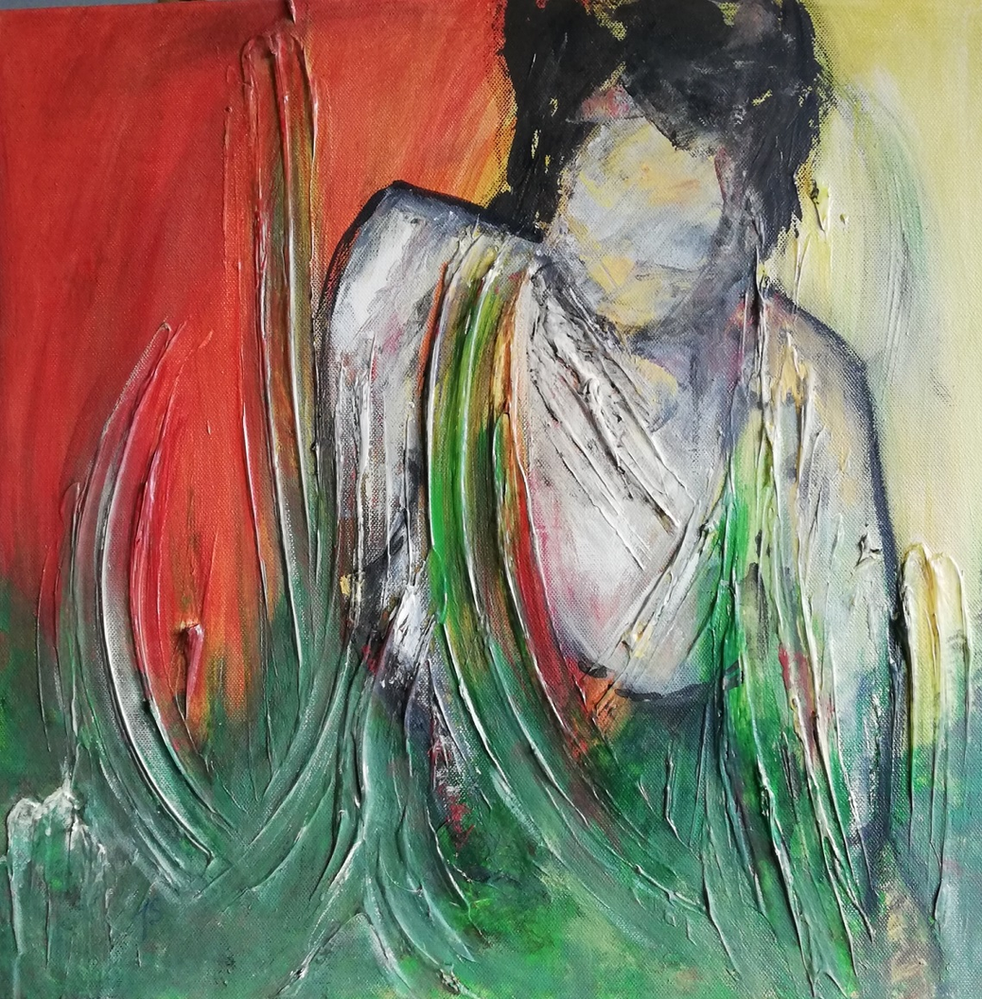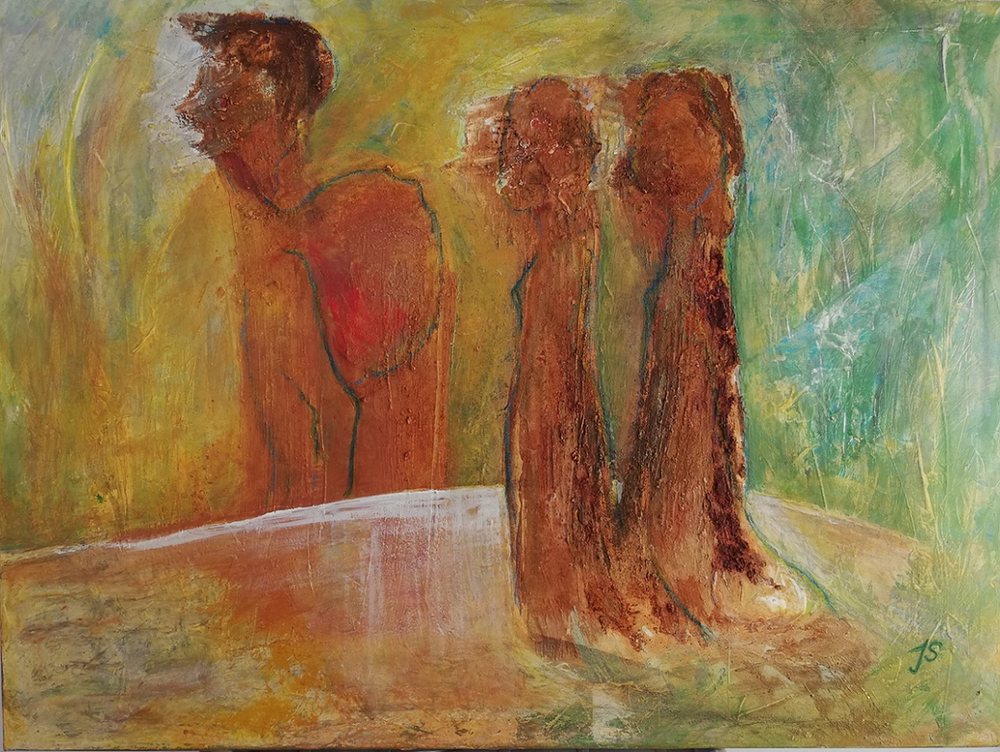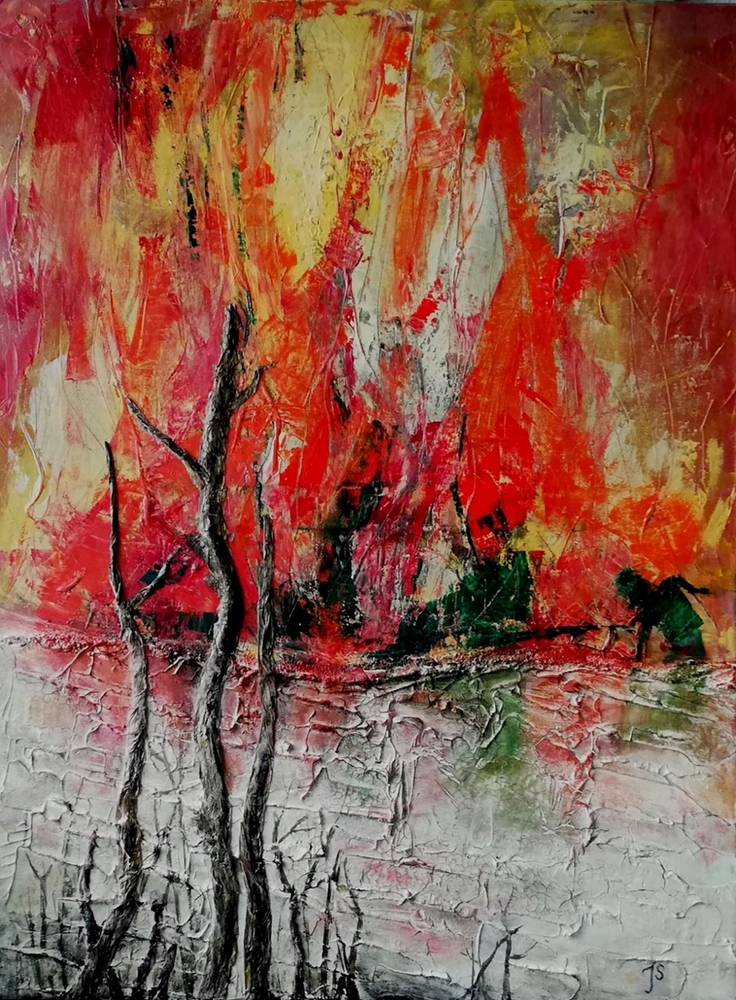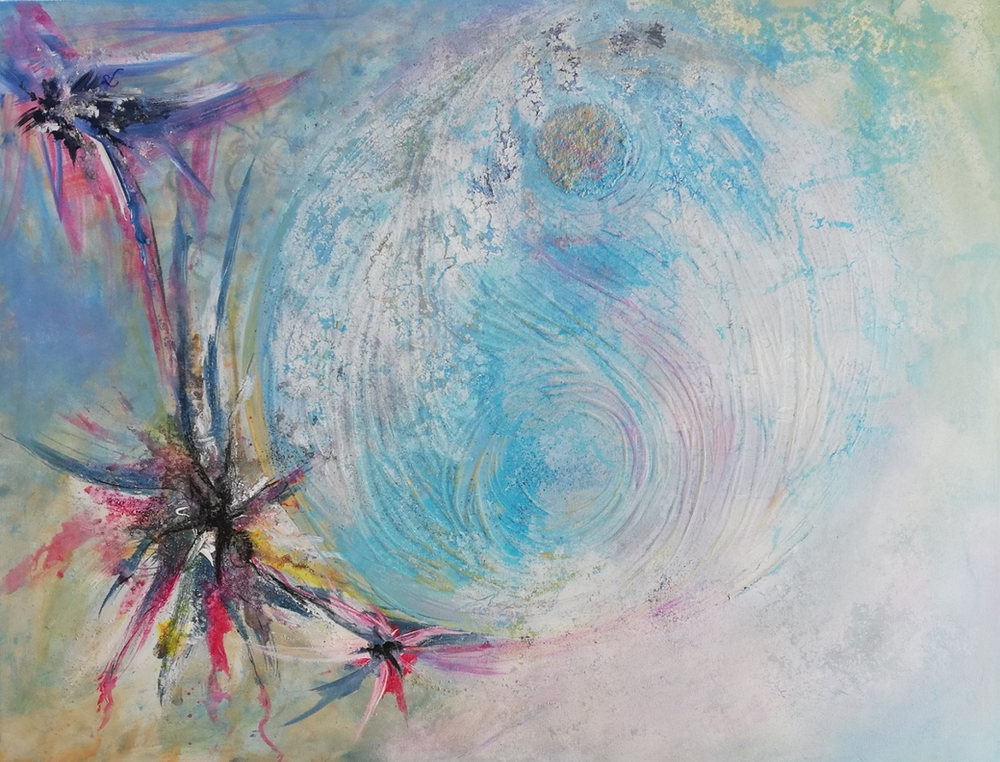
Judith Seiler – Schloemmer
Nel percorso di molti artisti l’incontro con la propria natura creativa avviene tardivamente, magari dopo aver trascorso gran parte della propria vita all’interno di un percorso professionale completamente opposto, o comunque lontano, dalla necessità di liberare le proprie emozioni che poi improvvisamente si svela. In alcuni casi questa presa di coscienza avviene a seguito di un evento, più o meno traumatico, che si verifica inaspettato e che riesce con il suo impatto a cambiare tutti i punti di vista fino a quel momento consolidati; per altri invece la consapevolezza coincide semplicemente con la possibilità di avere più tempo libero per meditare su se stessi e permettere alle proprie inclinazioni di affiorare e di essere accolte e inseguite fino a diventare predominanti nel percorso che scelgono di intraprendere. L’artista austriaca Judith Seiler-Schlömmer ha effettuato questo secondo tipo di cammino, una fase di profonda riflessione che l’ha condotta a comprendere quanto forte fosse la sua inclinazione verso l’espressività pittorica, verso quell’impulso a esprimere le proprie emozioni e sensazioni attraverso il racconto per immagini che fino a qualche anno prima non aveva immaginato potesse diventare il suo nuovo percorso. Per anni funzionaria presso il Comune della sua città, Graz, non appena si è ritirata dal lavoro ha ascoltato la propria interiorità che la spingeva inequivocabilmente verso la manifestazione visiva delle sensazioni che sentiva mormorare dentro di sé e ha cominciato a misurarsi con tele e colori, inizialmente senza alcuna formazione specifica bensì semplicemente ascoltando l’impellente desiderio di comunicare all’esterno il suo mondo interiore. Terminato il primo periodo in cui l’urgenza espressiva era forte e irrefrenabile, Judith Seiler-Schlömmer sente però il bisogno di assumere maggiori conoscenze, sui colori e sulle tecniche pittoriche e comincia perciò a seguire i corsi intensivi del professor Rudolf Szyszkowitz e seminari tenuti da Efti Schlamadinger a Graz e da Erich Meier a Salisburgo, ricevendo manifestazioni di stima e incoraggiamento a proseguire nel suo percorso artistico. Dal punto stilistico la Seiler-Schlömmer si avvicina indubbiamente all’Espressionismo Astratto, per l’impulsività dell’atto pittorico che avvolge le sue opere di pathos, lo stesso che percepisce lei stessa nel momento in cui si pone davanti alla tela bianca; non c’è un progetto, un pensiero di partenza quando inizia a dipingere, semplicemente si lascia andare a ciò che l’interiorità suggerisce, a ciò che le sensazioni intendono manifestare evocando un ricordo, un luogo, una sensazione assorbita e poi elaborata da quel mondo emotivo ricco e sensibile che diviene filtro e incubatore di tutto ciò che in un secondo tempo deve fuoriuscire. Pur avendo una forte componente astratta le opere di Judith Seiler-Schlömmer mantengono sempre anche una parte figurativa, a volte più velata altre invece più evidente, come se in alcuni casi le fosse necessario il contatto con la realtà osservata per essere in grado di concretizzare il turbinio profondo che i pensieri e le sensazioni che ruotano nel suo intimo le suscitano; quel contatto con ciò che lo sguardo conosce, sebbene sempre fortemente orientato all’Espressionismo e dunque collegato più al sentire che non al realisticamente osservare, ferma e immortala i concetti che l’artista ha bisogno di esprimere. L’opera Inferno

Inferno
è rappresentativa di questo suo stile ibrido, in cui le tonalità irreali e lo sfondo indefinito tipico dell’Espressionismo Astratto si sovrappongono al personaggio che si svela ma al tempo stesso tende a nascondersi, come se vi fosse nella Seiler-Schlömmer un’esortazione a tenere la guardia alzata e non fidarsi di un’apparenza rassicurante, costituita da quel verde nella parte bassa dell’opera, forse un prato, perché oltre può nascondersi l’insidia. Eppure nella tela On the way (In cammino)

On the way
evidenzia la necessità di dare fiducia e di affiancarsi a persone con cui camminare, con cui percorrere una strada che può condurre verso la conoscenza nuova, il futuro, la fiducia e la speranza. Andiamo ora a conoscere personalmente l’artista.Judith, ci racconta qual è stato il momento in cui ha capito che la pittura sarebbe stata la sua strada? C’è stato un evento specifico oppure è qualcosa che ha lentamente sentito maturare dentro di sé?
In realtà non c’è stato una circostanza che potrei definire il punto di partenza, il giro di boa che poi mi ha condotta a scoprire la mia inclinazione artistica; ho avuto una carriera professionale che mi ha impegnata, così ho dovuto dividermi tra il lavoro e la famiglia. Poi, quando sono andata in pensione, mi sono trovata ad avere molto tempo libero da riempire con tutto ciò che desideravo fare, sono tornata a essere padrona del mio tempo così mi sono messa ad ascoltare la mia interiorità e ho aspettato che il nuovo percorso si tracciasse da solo. La pittura si è manifestata dunque in maniera quasi inconscia perché mai prima di quel periodo avevo pensato di prendere in mano tele e pennelli, poi però si è trasformata nella mia grande passione e ora non riesco più a smettere di dipingere.
Quanto è stato importante il suo percorso professionale precedente per farle comprendere l’importanza e l’impellenza di scegliere l’arte visiva per liberare le sue emozioni?
All’interno del mondo del lavoro spesso tendevo a trattenere le emozioni, sia quelle positive che quelle negative, per infondere in chi mi stava intorno l’immagine di imperturbabilità professionale necessaria per tenere separate le due sfere della vita e per tutelare la mia vera personalità e anche la mia riservatezza. In quel modo però tendevo a trattenere dentro di me tristezze, momenti di sconforto, fasi delicate che nella vita è sempre necessario superare. Perciò in un certo senso quella riservatezza nell’ambito professionale mi ha aiutata a comprendere l’importanza di liberare le emozioni nascoste che altrimenti restano latenti e continuano a galleggiare senza mai essere risolte; attraverso la pittura ho imparato a liberarmi, a raccogliere nuove impressioni, nuove sensazioni senza più racchiuderle nel mio forziere emotivo bensì manifestandole attraverso i segni e i colori. In virtù di questa inedita comunicatività il mio ego ne esce rafforzato perché l’atto del dipingere mi ha aiutata, e mi aiuta a superare molti momenti di tristezza, di malinconia.

Auf der Lagd (A caccia)
Da quali tra i suoi maestri sente di aver assorbito di più lo stile e gli spunti creativi e a quali invece dei grandi artisti del passato si ispira o sente più affini al suo linguaggio espressivo?
Il professor R. Szyszkowitz ha intravisto il mio talento e mi ha incoraggiata a effettuare un percorso di perfezionamento e di sviluppo della mia tecnica espressiva. Erich Meier ha indirizzato il mio interesse verso i colori acrilici. Nei seminari e workshop con la signora E. Schlamadinger ho sviluppato la dinamica del colore, la struttura dell’immagine, la prospettiva, la composizione e diverse tecniche di pittura. Tra i grandi maestri del passato da cui ho tratto maggior ispirazione non posso non citare Paul Cézanne che con i suoi paesaggi mi ha affascinata soprattutto per la leggerezza e per la luminosità delle immagini, di Raoul Dufy amo la sua serie di barche a vela ormeggiate nei porti oppure naviganti nelle baie e infine Hans Hofmann, un pittore tedesco-americano di stile espressionista astratto di cui mi ha sempre conquistata l’accostamento delle tonalità forti e decise delle sue opere in grado di andare oltre la geometricità apparente attraverso la vibrazione dei colori.

It’s burning (Sta bruciando)
Lei si lascia completamente andare all’istinto mentre dipinge, senza avere un’idea di dove la condurrà la sua creatività; ci spiega meglio questo concetto? Anche la scelta delle tonalità è dettata dall’impulso irrazionale oppure c’è un momento in cui entra in gioco anche la mente?
Quando poggio il pennello sulla tela sono in balìa di una spinta interiore che mi si manifesta sotto forma di immagine ma è difficile per me riuscire a comprendere se questo è il riflesso di qualcosa che ho letto, sognato o vissuto. Tutto dipende dall’ispirazione del momento, dall’impulso creativo, è per questo che non c’è un’idea di partenza, semplicemente mi metto di fronte al cavalletto e mi lascio andare alle sensazioni che la mia interiorità fa fuoriuscire. Io astraggo dal generale a ciò che è essenziale per me e questo è determinato da un lato dalla mia creatività, dall’altro dalla percezione dello spettatore che diviene interprete del linguaggio o del pensiero dell’esecutore. L’ambiguità emotiva è una delle maggiori forze e attrazioni della pittura, quella attraverso cui non è importante se il messaggio dell’artista venga pienamente compreso così come da lui è fuoriuscito, ciò che conta è la sensazione che l’osservatore riceve, emozionandosi sulla base del proprio vissuto, del proprio stato d’animo del momento, del proprio modo di pensare e di leggere quello che sta vedendo.

Ohne Titeiln (Senza titolo)
Quali sono i suoi prossimi progetti?
Maxim Gorky, uno scrittore russo, disse una volta: “La scienza è la mente del mondo, l’arte la sua anima” perciò mi attengo a questo pensiero per determinare il mio cammino nell’arte perché finché sentirò forte come adesso il bisogno di continuare a dipingere non mi fermerò ed userò questo mezzo di espressione che è molto affine alle mie corde. Per ora ho in programma la partecipazione a Vienna Art Summer, mostra collettiva internazionale che avrà luogo presso la galleria Publicartists dal 18 luglio al primo agosto.
JUDITH SCHLÖMMER-CONTATTI
Email: schloemmer.ju@gmx.net
Facebook: https://www.facebook.com/judith.seiler.90
Marta Lock’s interviews:
Judith Seiler-Schlömmer, art as the discovery of one’s true nature
In the path of many artists, the encounter with their own creative nature comes late in life, perhaps after having spent a large part of their lives in a professional career completely opposed to, or at least far removed from, the need to free their emotions, which then suddenly reveals itself. In some cases, this awareness comes about following an event, more or less traumatic, which occurs unexpectedly and which, with its impact, manages to change all the points of view that had been consolidated up to that moment; for others, on the other hand, awareness simply coincides with the possibility of having more free time to meditate on oneself and allow one’s own inclinations to surface and be accepted and pursued until they become predominant in the path they choose to take. The Austrian artist Judith Seiler-Schlömmer took this second type of path, a phase of profound reflection that led her to realise how strong her inclination was towards pictorial expression, towards that impulse to express her emotions and sensations through narrative in images that until a few years before she had not imagined could become her new path. As soon as she retired from her job, she listened to her inner self, which urged her unequivocally towards the visual manifestation of the feelings that she felt were murmuring within her, and she began to measure herself with canvases and colours, initially without any specific training but simply listening to the impelling desire to communicate her inner world to the outside one. After the first period in which the expressive urgency was strong and unstoppable, Judith Seiler-Schlömmer felt the need to acquire more knowledge about colours and painting techniques and therefore began to attend intensive courses held by Professor Rudolf Szyszkowitz and seminars held by Efti Schlamadinger in Graz and Erich Meier in Salzburg, receiving expressions of esteem and encouragement to continue on her artistic path. In terms of style, Seiler-Schlömmer is undoubtedly close to Abstract Expressionism, due to the impulsiveness of the pictorial act that envelops her artworks in pathos, the same pathos that she herself perceives when she stands in front of the blank canvas; there is no plan, no starting thought when she begins to paint, she simply lets herself go to what her interiority suggests, to what her sensations intend to manifest, evoking a memory, a place, a sensation absorbed and then processed by that rich and sensitive emotional world that becomes a filter and incubator for everything that must later come out. Although Judith Seiler-Schlömmer’s artworks have a strong abstract component, they also always maintain a figurative part, sometimes more veiled, sometimes more evident, as if in some cases she needed to be in contact with the observed reality in order to be able to realise the profound whirlwind that the thoughts and sensations which revolve within her inner self provoke; that contact with what the eye knows, although always strongly oriented towards Expressionism and therefore linked more to feeling than to realistic observation, stops and immortalises the concepts that the artist needs to express. The work Inferno is representative of this hybrid style, in which the unreal tones and indefinite background typical of Abstract Expressionism are superimposed on the character who reveals himself but at the same time tends to hide, as if Seiler-Schlömmer were exhorting us to keep our guard up and not to trust a reassuring appearance, consisting of that green in the lower part of the painting, perhaps a meadow, because beyond it lies the trap. And yet, in the canvas On the way, she emphasises the need to give confidence and to place oneself alongside people with whom to walk, with whom to travel a road that can lead towards new knowledge, the future, confidence and hope. Let us now get to know the artist personally.
Judith, can you tell us about the moment when you realised that painting would be your path? Was there a specific event or was it something that you slowly felt maturing within you?
Actually, there was no circumstance that I could define as the starting point, the turning point that then led me to discover my artistic inclination; I had a professional career that kept me busy, so I had to divide myself between work and family. Then, when I retired, I found I had a lot of free time to fill with whatever I wanted to do, I became the master of my time again, so I listened to my inner self and waited for the new path to trace itself. So painting manifested almost unconsciously, because before that period I had never thought of picking up canvases and brushes, but then it became my great passion and now I can’t stop painting.
How important was your previous professional career for you to understand the importance and urgency of choosing visual art to release your emotions?
Within the working world, I often tended to hold back my emotions, both positive and negative, in order to instil in those around me the image of professional imperturbability necessary to keep the two spheres of life separate and to protect my true personality and also my confidentiality. In this way, however, I tended to keep within myself sadness, moments of discouragement, delicate phases that in life you always have to overcome. Therefore, in a certain sense, this confidentiality in the professional sphere helped me to understand the importance of freeing the hidden emotions that otherwise remain latent and continue to float around without ever being resolved; through painting I learned to free myself, to gather new impressions, new sensations without enclosing them in my emotional coffer but rather manifesting them through signs and colours. By virtue of this unprecedented communicativeness, my ego has been strengthened, because the act of painting has helped me and continues to help me overcome many moments of sadness and melancholy.
From which of your masters do you feel you have absorbed the style and creative ideas the most, and from which of the great artists of the past do you draw inspiration or feel the most affinity with your expressive language?
Professor R. Szyszkowitz saw my talent and encouraged me to refine and develop my expressive technique. Erich Meier directed my interest towards acrylic colours. In seminars and workshops with Mrs E. Schlamadinger, I developed colour dynamics, image structure, perspective, composition and various painting techniques. Among the great masters of the past from whom I have drawn the most inspiration, I cannot fail to mention Paul Cézanne, whose landscapes fascinated me above all because of the lightness and luminosity of the images; I love Raoul Dufy’s series of sailboats moored in harbours or sailing in bays; and finally Hans Hofmann, a German-American painter of abstract expressionist style, whose works have always fascinated me with their combination of strong, decisive colours that go beyond apparent geometricity through the vibration of colours.
You let yourself go completely by instinct while painting, without having any idea of where your creativity will lead you; can you explain this concept to us? Is the choice of colours also dictated by irrational impulse or is there a moment when the mind comes into play?
When I put the brush to the canvas I am at the mercy of an inner urge that manifests itself to me in the form of an image, but it is difficult for me to understand whether this is a reflection of something I have read, dreamt or experienced. It all depends on the inspiration of the moment, on the creative impulse, which is why there is no starting point, I simply stand in front of the easel and let myself go to the sensations that my inner self releases. I abstract from the general to what is essential to me, and this is determined on the one hand by my creativity, and on the other by the perception of the viewer who becomes an interpreter of the language or thought of the performer. Emotional ambiguity is one of the greatest strengths and attractions of painting, the one through which it is not important whether the artist’s message is fully understood as it comes out of him, what counts is the feeling that the viewer receives, moving on the basis of his own experience, his mood of the moment, his way of thinking and reading what he is seeing.
What are your next projects?
Maxim Gorky, a Russian writer, once said: “Science is the mind of the world, art is its soul”, so I am sticking to this thought to determine my path in art because as long as I feel the need to continue painting as strongly as I do now, I will not stop and I will use this means of expression which is very close to my heart. For the time being, I am going to participate in the Vienna Art Summer, an international group exhibition that will take place at the Publicartists gallery from 18 July to 1 August.
